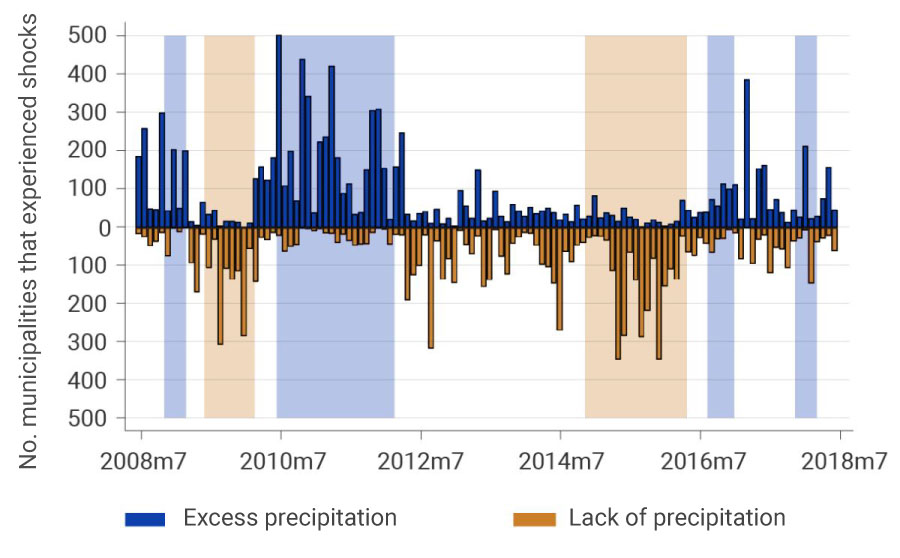Scientific evidence has shown that extreme weather events, including excessive precipitation and droughts, are becoming longer and more severe due to the effects of climate change. If agricultural producers do not adjust to this new reality, produce shortages and higher food prices can be expected. Colombia's geographic location makes it particularly vulnerable to this global reality. The results of two studies that explore the adjustment mechanisms that Colombian farmers seem to make in the face of droughts and periods of excessive rainfall are described below. The first is the change in formal employment patterns. The second is the change from permanent to seasonal crops.
To fully comprehend these two changes, it is important to understand how rainfall affects Colombian countryside. Due to its location close to the equator, the country is more prone to suffer the consequences of El Niño and La Niña. Between 2008 and 2018, there were two El Niño periods (low rainfall) and four La Niña periods (excess rainfall). Graph 1 shows that in the most intense months of El Niño, nearly 500 of the country's 1,120 municipalities experienced lack of rainfall. During the most intense months of La Niña, between 200 and 400 municipalities experienced excessive rainfall. The graph also shows that when Colombian municipalities are not under the effects of La Niña or El Niño, they are more likely to experience shortages than excesses of rainfall. The differences in the number and type of municipalities affected by episodes of excess or lack of rainfall allow us to measure the adaptations in employment and crop types that we discuss below.
Graph 1: Incidence of episodes of lack of and excess rainfall in the municipalities of Colombia – monthly 2008-2018

Notes. The blue bars represent the number of municipalities with monthly precipitation above the 80th percentile of the historical distribution for the same month during the last 30 years. The red bars represent the number of districts with monthly precipitation below the 20th percentile of the municipality’s historical distribution.
In a recent working paper, Camilo Bohórquez and Andrea Otero, researchers at Banco de la República, use meteorological data and administrative records of social security contributions to measure the effect of excess or lack of rainfall on formal employment in the country's rural municipalities. The results of the analysis show that months with excessive rainfall generate a 2.3% drop in formal employment in these municipalities, on average. In contrast, in months with very low rainfall, formal employment increases 1.7%, on average. These employment adjustments are not accompanied by significant changes in wages.
The estimated effects of climate on formal employment are consistent with changes in production decisions and farmers' use of inputs to mitigate the effects of climate shocks. It is possible that in times of very limited rainfall, the use of labor devoted to irrigation activities increases. Such an adjustment is more feasible for producers with lower liquidity constraints who are more likely to hire more workers under formal contracts. Likewise, rainfall shocks can lead to changes in land use which, in turn, can generate increases in the demand for employment. In a study currently in progress, Camilo Bohórquez finds precisely that in years with scarce rainfall, Colombian municipalities experience an expansion in the area devoted to permanent crops (such as coffee, sugar cane, and fruit trees), which require a greater use of labor for land preparation. These results illustrate the adjustment agricultural producers make to climate shocks that are expected to be more severe and persistent due to climate change.








































































